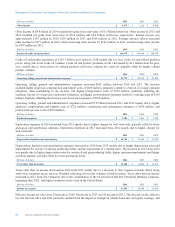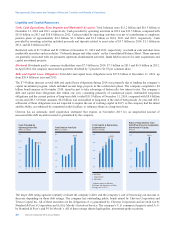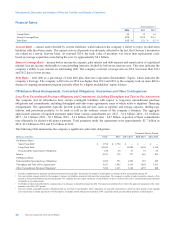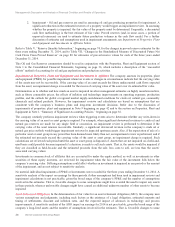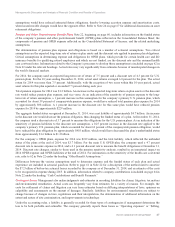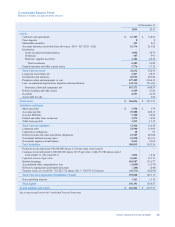Chevron 2014 Annual Report Download - page 26
Download and view the complete annual report
Please find page 26 of the 2014 Chevron annual report below. You can navigate through the pages in the report by either clicking on the pages listed below, or by using the keyword search tool below to find specific information within the annual report.
Management’s Discussion and Analysis of Financial Condition and Results of Operations
Litigation and Other Contingencies
MTBE Information related to methyl tertiary butyl ether (MTBE) matters is included on page 50 in Note 15 to the
Consolidated Financial Statements under the heading “MTBE.”
Ecuador Information related to Ecuador matters is included in Note 15 to the Consolidated Financial Statements under the
heading “Ecuador,” beginning on page 50.
Environmental The following table displays the annual changes to the company’s before-tax environmental remediation
reserves, including those for federal Superfund sites and analogous sites under state laws.
Millions of dollars 2014 2013 2012
Balance at January 1 $ 1,456 $ 1,403 $ 1,404
Net Additions 636 488 428
Expenditures (409) (435) (429)
Balance at December 31 $ 1,683 $ 1,456 $ 1,403
The company records asset retirement obligations when there is a legal obligation associated with the retirement of long-
lived assets and the liability can be reasonably estimated. These asset retirement obligations include costs related to
environmental issues. The liability balance of approximately $15.1 billion for asset retirement obligations at year-end 2014
related primarily to upstream properties.
For the company’s other ongoing operating assets, such as refineries and chemicals facilities, no provisions are made for exit
or cleanup costs that may be required when such assets reach the end of their useful lives unless a decision to sell or
otherwise abandon the facility has been made, as the indeterminate settlement dates for the asset retirements prevent
estimation of the fair value of the asset retirement obligation.
Refer to the discussion below for additional information on environmental matters and their impact on Chevron, and on the
company’s 2014 environmental expenditures. Refer to Note 23 on pages 65 through 67 for additional discussion of
environmental remediation provisions and year-end reserves. Refer also to Note 24 on page 67 for additional discussion of
the company’s asset retirement obligations.
Suspended Wells Information related to suspended wells is included in Note 20 to the Consolidated Financial Statements,
Accounting for Suspended Exploratory Wells, beginning on page 57.
Income Taxes Information related to income tax contingencies is included on pages 53 through 56 in Note 16 and page 65 in
Note 23 to the Consolidated Financial Statements under the heading “Income Taxes.”
Other Contingencies Information related to other contingencies is included on page 66 in Note 23 to the Consolidated
Financial Statements under the heading “Other Contingencies.”
Environmental Matters
Virtually all aspects of the businesses in which the company engages are subject to various international, federal, state and
local environmental, health and safety laws, regulations and market-based programs. These regulatory requirements continue
to increase in both number and complexity over time and govern not only the manner in which the company conducts its
operations, but also the products it sells. Regulations intended to address concerns about greenhouse gas emissions and
global climate change also continue to evolve and include those at the international or multinational (such as the mechanisms
under the Kyoto Protocol and the European Union’s Emissions Trading System), national (such as the U.S. Environmental
Protection Agency’s emission standards and renewable transportation fuel content requirements or domestic market-based
programs such as those in effect in Australia and New Zealand), and state or regional (such as California’s Global Warming
Solutions Act) levels. Regulations intended to address hydraulic fracturing also continue to evolve at the national and state
levels.
Most of the costs of complying with laws and regulations pertaining to company operations and products are embedded in
the normal costs of doing business. It is not possible to predict with certainty the amount of additional investments in new or
existing facilities or amounts of incremental operating costs to be incurred in the future to: prevent, control, reduce or
eliminate releases of hazardous materials into the environment; comply with existing and new environmental laws or
regulations; or remediate and restore areas damaged by prior releases of hazardous materials. Although these costs may be
significant to the results of operations in any single period, the company does not expect them to have a material effect on the
company’s liquidity or financial position.
24 Chevron Corporation 2014 Annual Report






